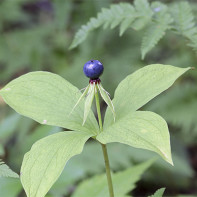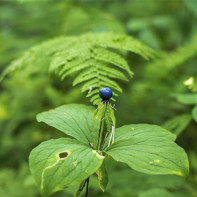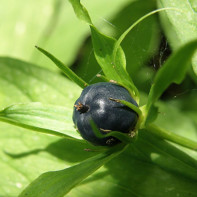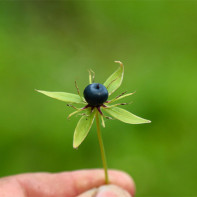Crow's eye: medicinal properties and contraindications
In families where several generations have a tradition to go to the woods every season to pick mushrooms and berries, since childhood they know: if you saw leaves and berries of crow's-eye - pass by, do not touch, because this plant is poisonous. So poisonous that even insects shun it, so it is never eaten or damaged by pests.
- Chemical composition
- What it looks like and where it grows
- Collection and storage
- Crow's eye medicinal properties
- Crow's eye in folk medicine
- For Wound Care
- Juice for headache
- Tincture for headache
- Laxative
- Concussion
- For eye inflammation
- For cramps
- Laryngitis
- Types of medicinal compositions
- Decoction
- Ointment
- Tincture
- What happens if you eat crow's eye
- Contraindications to use
- Symptoms of poisoning
- Interesting Facts
Chemical Composition
Botanical scientists have studied crow's eye in all the details and have long established that its danger is associated primarily with the fact that the berries and rhizome contain glycosides paridin and paristifin, which brightly show neurotoxic effect, having a poisonous effect on the nervous tissue, destroying it. At the same time, in a reasonable prescribed dosage, they can also help in the fight against neoplasms, eliminate any blood flow disorders, normalizing blood composition and density, fight against fungal infection and inflammatory processes.
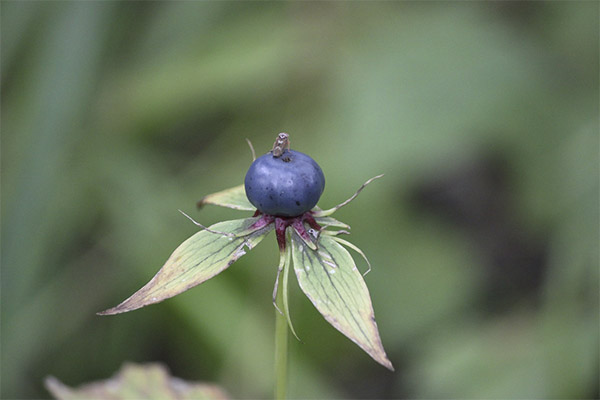
The plant also contains steroid saponins, whose role is to inhibit the development of pathogens and very useful substances flavonoids, which have a beneficial effect on the capillary walls, strengthening them and normalizing the activity of the heart muscle.
In the list of useful components of crow's eye - coumarins, which promote blood thinning and prevent thrombosis, as well as pectins - substances that help maintain normal intestinal microflora.
There is also a set of organic acids in the plant, thanks to their participation in maintaining the acid-base balance of the human body, the immune system, the digestive tract, every cell of the body function, which improves the overall condition and well-being of man, increases his life potential. Approximately the same role is played by vitamin C, of which the herb contains a lot.
How it looks and where it grows
Crow's eye is a perennial plant. Its rhizome stretches far to the sides, not particularly deepening into the ground (botanists call this kind of root creeping). Every spring the root expands into the adjacent territory, giving more and more offshoots. In spite of a wide area taken over, a single shoot grows from the root - straight, ribbed, but smooth, having no pubescence.
On the upper part of an erect shoot 10 to 40 cm in height, a whorl is formed - that is, a place from which four fairly broad leaves grow at the same level, arranged evenly around the circumference and clearly in pairs opposite each other, like a cross. The leaves are elongated, oval, with a pointed tip, and are about 10 cm long. Although the crow's eye belongs to the monocotyledonous class, which is characterized by the longitudinal arrangement of the veins on the leaf, its veins are reticulate.
From the center of this peculiar cross of leaves rises a short and not very thick peduncle on which there is an inconspicuous greenish flower consisting of two rows of narrow, very petal-like sepals. The outer row is green, about 4 cm long, while the inner row is smaller, yellow-green. On the whole, the flower resembles the shape of a star with pointed rays. It flowers from late May and early June until the first days of August and then forms a large, shiny berry, which is why the crow's eye gets its name. The berry is red at first, but turns a dense black color with a grayish-gray patina as it ripens.
The round berry is 1 cm in diameter and has four nests-chambers inside with a large number of seeds. If you crush the fruit, the juice splashes out and you immediately feel a characteristic heavy smell. The berry also tastes unpleasant, it is sour and bitter. Ripens in August and looks similar to blueberries or blueberries, so it is important to teach children to distinguish the poisonous plant and not to touch the outwardly attractive, but deadly berry. It is in it the greatest concentration of poisonous substances, the shoots and leaves are less toxic.
Crow's eye prefers to occupy shady places, likes damp loams, rich in humus, this explains its main place of residence - deciduous and mixed forests. But the plant also adapts well to coniferous forests, where the soil is acidified with coniferous decay. It can be found on lake and river shores, in ravines, forest edges, undergrowth, bushes and even forest-steppe. This plant reproduces itself by seeds, which the wind and especially birds are able to carry to very long distances.
In nature there are several varieties of crow's eye. For example, the common four-leafed grows everywhere in forests from Central Europe to Kamchatka and the Asian region. It prefers temperate climates, and the weather conditions of southern Europe, the Mediterranean coastal regions, as well as Asia and North America are unfavorable for its growth. In Russia, crow's-eye is not found only in regions with a rather harsh climate, such as Chukotka and the Yamalo-Nenets Okrug.
In the swampy areas of the Volga region, the Caucasus and Western Siberia, crow's eye, called incomplete, is found; in the mountains of the Himalayas, a variety called multifoliate has settled, these plants have not four, but eight to ten leaves.
In Russia, there are also (although rare) specimens of crow's eye with five and even six leaves. They are observed in the Far East - in shady places, on acidified moist soils of forests and ravines. The seeds of the common four-leafed plant were brought here by migrating birds, but because of the specific climate they were transformed into new, now-existing varieties.
Harvesting and storage
Crow's head grass begins to be collected at the beginning of summer, when the plant is just beginning to bloom. It is during this period that it is most suitable for medicinal purposes. Going for medicinal raw materials, herbalists protect as much as possible the body and eyes from contact with the leaves and contact with the skin and mucous membranes juice, which can cause irritation and even a slight burn. Clothing is worn tight, with long sleeves and buttoned cuffs, supplemented by gloves and safety glasses.
The plant is cut with a sharp knife to the root and put it in a shaded, hidden from the sun room where ventilation is good or there is a draught. The cut material is spread in a small layer on paper and occasionally turn it over so that it dries evenly.
Dried grass is put in canvas bags or sufficiently thick bags of paper. On the bag or bag must be written, what plant is in it and point out that it is poisonous.
Berries are harvested when they are fully ripe. This is indicated by their color, which is thick black with a grayish-grayish patina. Berries can be dried under the same conditions as herbs, or speed up the drying process with an electric dryer. Also berries can be frozen in the freezer. But in both cases, the name of the contents should be indicated on the bags or containers, mentioning the presence of poison.
Roots are not taken, they are unsuitable for medicinal use, because they cause the strongest intoxication of the body.
Therapeutic properties of crow's eye
Official medicine does not use means on the basis of the raven's eye because of the high toxicity of the plant. Folk healers are also very careful and cautious with the prescription and recommendations of medicinal compositions based on it. The herbalists mostly use the ability of the plant to induce vomiting and have a laxative effect.
In addition, since ancient times, veduns decoctions of the raven's eye reduce the intensity of spasms caused by disorders of the nervous system, treat inflamed throat, migraine, are used for heart ailments accompanied by an increase in heart rate. More freely used means of crow's eye externally: treat pustules, ulcers, boils, purulent rash, put on wounds after a rabid dog bite (necessarily after all appointments, injections and inoculations made in the official medical institutions). To this end, use the juice of the plant, mush, water decoctions or alcoholic tinctures. Moreover, each recommendation and each recipe for use is necessarily accompanied by an admonition: use only under the supervision of a doctor.
Homeopaths use remedies prepared from the raven's eye more widely. As you know, homeopathy treats ailments with small, almost microscopic doses of substances or highly diluted preparations. Meanwhile, it has nothing to do with official health care, homeopaths are considered representatives of non-traditional medicine.
From the fresh green part they make a homeopathic remedy, used to relieve neuralgic pains of the face, head, with frequent inflammations of the throat and larynx. The same remedy is used to relieve eyelid twitching in conjunctivitis. The course of treatment with such remedies is usually long.
Homeopaths claim that the human body will not be harmed if the plant is used in a reasonable dosage. A small amount of pyridine and paraffin, which make up the leaves and fruits, is successfully destroyed in the stomach under the influence of hydrochloric acid and enzymes. Moreover, homeopaths emphasize that it is necessary to use plants harvested during flowering, because during this period the leaves and stems contain the least amount of poisonous substances. They make good medicinal tinctures and decoctions.
For therapeutic purposes, the raven's eye ability to have a calming effect on the nervous system, to relieve spasms of different origin, to treat inflammation, and to exhibit a diuretic effect is used. The plant has a positive effect on the circulatory system, thinning the blood, improving its microcirculation and passage through the soft tissues, at the same time accelerating the healing of wounds.
From the freshly picked plant, preparations are made to treat cardiac problems such as arrhythmias, particularly tachycardia, or palpitations. Crow's eye remedies are used for a large group of respiratory diseases of colds - angina, laryngitis and tonsillitis, inflammation of the sinuses - sinusitis and maxillitis, as well as bronchitis. Even with such a serious disease as tuberculosis, homeopaths prescribe remedies from this plant.
In the same list are severe pains caused by neuritis, and such problems are also cured by the plant. In the same list are severe pains that have appeared against the background of neuritis, with such problems the healing compositions of the plant also cope. Here manifests its sedative effect, which is also used to treat psychosomatic and mental disorders, to alleviate nervous tics, to establish the work of the internal secretion glands and restore the normal balance of hormones.
When properly used, the plant improves the digestive tract, normalizes appetite, relieves swollen feet, relieves rheumatic pains.
To cure each problem, the drug is used in its specific dosage, in the right degree of dilution. The treatment must be carried out under the supervision of a homeopathic physician. Self-prescription and use of Crow's Eye remedies is strictly forbidden! Abuse and overdose of such drugs is not recommended, possibly poisoning.
Crow's eye in folk medicine
Crow's eye is most often infused with vodka or alcohol for medicinal purposes, such compositions are recommended by herbalists to relieve headaches, restore normal sleep, relieve heart disease. Alcohol compositions are also used to treat skin problems: wounds and ulcers. They can get rid of pain and inflammation in the joints, relieve muscle cramps and calm the nervous system.
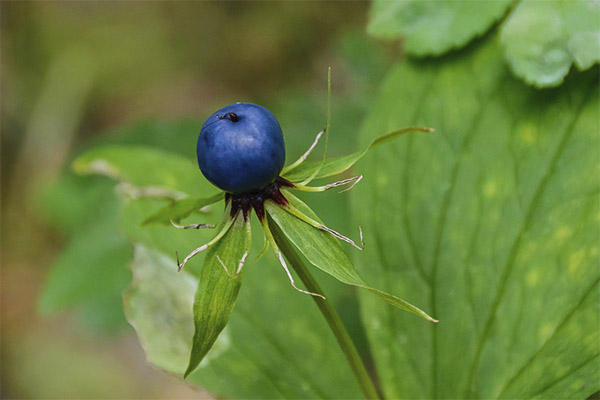
To treat wounds
To cope with wounds that are hard to heal, you need to take as many berries so that in crushed form they can cover the entire sore spot. Suppress the berries, the resulting mass to smear the festered wound, abrasion, pus rash or pimples. For treatment, it is enough to apply the remedy once a day.
Juice for headaches
Juice will help as an emergency remedy for migraines and non-pressure headaches. The pain will subside if you rub the juice on your temples. Both berries and herbs are used to obtain the liquid medicine, which should be brought to a mushy state in a blender before squeezing.
You can use this method no more than once a day, this remedy is prohibited for hypertension.
Tincture for headaches
To treat migraine and make the attacks more rare and less severe, it is necessary to prepare a healing composition of half a liter of vodka and 10 berries. Put the mixture in a closet for 2 weeks, then strain. Before treatment, drop 25 drops of the resulting tincture in 50 ml of water and take 3 times a day. The course of treatment - 3 weeks.
Laxative
Soak 50 g of the stem of the plant in half a liter of vodka, having previously cut it into small pieces. Remove the composition in a place out of reach of sunlight for 3-4 weeks, then strain. Store the tincture in the refrigerator, prepare the therapeutic composition directly on the day of use. Dissolve 2 teaspoons of tincture in a glass of water. Drink the composition within a day, taking a tablespoon after 2-3 hours.
For concussion of the brain
Take 4 tablespoons of crows eye berry pulp, sprinkle them in half a liter of vodka and put in a dark place for 10 days, then filter and take 5 drops three times a day for a week.
For inflammation of the eyes.
Crow's eye can be used by folk healers not only as a solo plant, but also as a component of herbal gatherings. To heal inflammatory eye disease, they prepare a mixture of taken in equal doses of red clover, meadow geranium flowers, cornflower, bird cherry berries, greens crow's-eye and lumbago. A tablespoon of the resulting mixture should be pour a glass of boiling water and leave to infuse for an hour, then soak cotton pads with the infusion and put on the eyes, making lotions. Treat until fully recovered.
To relieve cramps
Mix 200 ml of alcohol in a glass pot with 2 g of dry prepared herbs. Treatment can begin after a week of standing the remedy. Before taking a tablespoon of tincture dilute with the same amount of water. This composition to drink every 2 hours during the day. If the cramps are strong, the break between doses can be reduced to an hour, but in general, the amount of the remedy should not exceed a glass per day. The treatment time is a week.
With laryngitis.
Take 30 g of dried and ground into a powder crows eye green, poured into 400 ml of water heated to boiling and send to a water bath, where to keep after boiling for 20 minutes. Remove, cool and strain through a cloth or gauze folded in 6-8 layers. Drink 3 times a day - before breakfast, lunch and dinner - 30 ml (or 2 tablespoons). Store the remedy in the refrigerator and take a course of no more than a week - exactly as long as it will retain therapeutic properties.
The composition prepared according to this recipe is also suitable for the treatment of tachycardia and nervous disorders, as well as for their prevention.
Types of healing compositions
Do not forget: it is forbidden to self-prescribe treatment with compositions from this medicinal plant. The danger lies in a possible overdose, and even heat treatment does not reduce the danger, because the poisonous substances from the plant do not leave. Overdose can lead to serious problems with the heart and blood vessels, respiratory and nervous system suppression.
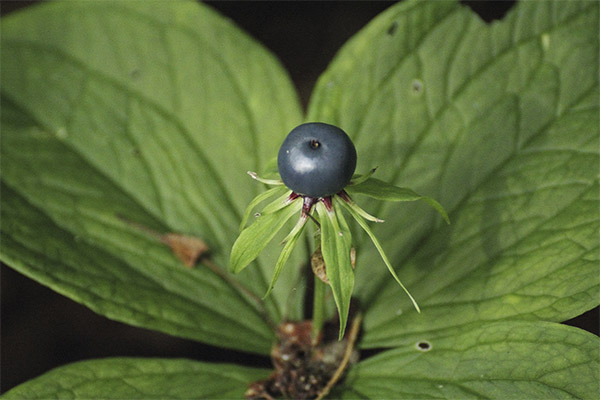
For making medicinal compositions - decoctions and tinctures - usually take fresh herbs, although in some cases - and dried herbs. Herbalists also recommend berries as a raw material.
Decoction
Pour a mug (350 ml) just boiling water a tablespoon of dried, lightly crushed leaves of crows eye. Cover the mixture with a saucer and put on a water bath. After standing over boiling water for 5-7 minutes, remove and leave to infuse for 25-30 minutes, after which be sure to strain. Inside use in homeopathic, small doses. To prepare lotions, soak a gauze cloth in the decoction and apply to the problem area, such as poorly healing wounds or ulcers.
Ointment
To treat ulcers, you can make lotions with decoction of the plant or prepare an ointment. To treat ulcers, squeeze the juice from the green part of the plant and mix it with any drugstore ointment used to treat infectious and purulent wounds, such as ichthyol. Prepare a portion of the medicine for one application and apply it once a day. As a rule, a one-week course of treatment is enough.
Tincture
- From the leaves. To prepare an alcoholic tincture you will need 10 g of fresh crows eye leaves. Crush them and pour half a glass of alcohol. Infusion time is one week. Insist, like any other medicinal plant in alcohol, in a dark glass bottle, shaking daily. Then strain and store in a dark cool place. Use a remedy only strongly diluted, in the proportion of a tablespoon per glass of water. Tincture is recommended if a nervous tic on the face or eyelid does not give rest. Within a day, you should drink no more than 200 ml of the composition in diluted form.
- From berries. To prepare a tincture, you must pour 10 berries (no more!) Half a liter of good vodka. Berries are good both fresh and dried or frozen. Insist the remedy for at least 14 days in a dark place. Shake the bottle with a tincture every day. Take a strong dilution of water: 50 ml of water - 20 drops of tincture. This is a daily rate, it is divided into three doses. Do not dilute the drug, every day prepare a new portion. Used in disorders of the nervous system and heart failure. Course reception - 3 weeks. If there is a need for further treatment, the remedy to continue not earlier than 10 days.
What happens if you eat crow's eye
Despite the strong poisonous nature of the plant, if you accidentally eat a berry or even 2-3, nothing terrible will happen. Yes, it is unpleasant, but not fatal. Panic early, you need to take a few tablets of activated charcoal, and the condition will improve.
But a larger number of berries, eaten at one time, for example, 8-10 pieces, will make themselves felt very soon. Already after an hour there will be signs of severe poisoning, because the digestive system began to absorb harmful substances in the blood.
Contraindications for use
- The first and most important rule is to treat with remedies based on the plant only after discussing this issue with your doctor, strictly following his recommendations, both on the dosage and on the mode of application.
- Crow's eye is strictly forbidden to pregnant and breastfeeding women, as well as children.
- Hypertension, single high blood pressure and insomnia are also contraindications to the treatment of crow's eye.
- Do not use preparations from this plant to patients suffering from diseases of the kidneys and excretory system, as well as those who are subject to allergic reactions.
Symptoms of poisoning
If you inadvertently eat a few raven's eye berries, signs of poisoning will soon appear.
Strong, perhaps even indomitable vomiting will open, diarrhea will appear, accompanied by heartburn and severe pain in the abdomen, in the stomach area. There may be a burning sensation in the mouth, and swallowing will be painful and difficult. There will be severe pain in the temples, the head will become very dizzy, even loss of consciousness is possible. Body temperature and blood pressure will rise, there will be signs of respiratory, heart and vascular system disorders - tachycardia, heart rhythm disorder. If poisoning is severe - it may come to a disorder of the coordination of movements, impaired speech, seizures up to complete paralysis and cardiac arrest. If you eat 15-20 berries, it is very likely to die, but even if the person survives, he may remain paralyzed for life.
In such a situation, you should immediately call an ambulance to the victim, and while it is on its way, give him a soda solution (for which to pour a half teaspoon of soda, or 5 g, into a liter of water and stir it). If you do not have soda on hand, you can simply give a large amount of water to drink - at least three glasses for an adult, the calculation of liquid for a child depends on the age - from 150 ml for each year of his life. It is important to flush the stomach of the contents.
The patient can take activated charcoal, Enterosgel, Polysorb, Smecta or Polifepan as a neutralizing agent for toxins.
To stop the absorption of toxic substances by mucous membranes, you need to give the victim a drink of vegetable oil (1-1.5 tablespoons), milk, whites of chicken eggs or decoction of starch.
Soothing the burning in the mouth and nausea can be helped by sucking ice cubes. For severe diarrhea, give the victim Regidron to avoid dehydration.
When the ambulance arrives, the doctor will administer a drug to improve heart function, and for the rapid removal of toxins and bringing the body back to normal - a solution of glucose, vitamins, hepatoprotectors, diuretics.
Interesting Facts
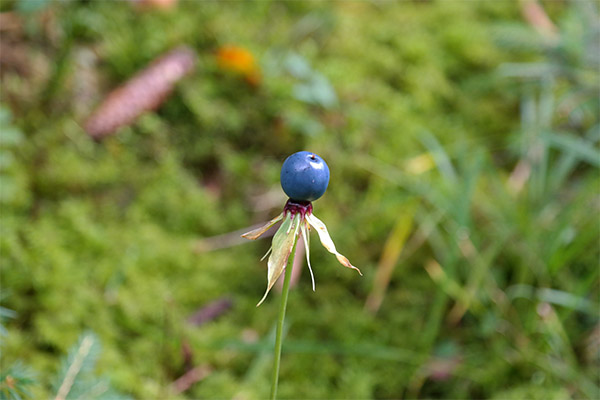
- Crow's eye can grow only on good nutritious soil, so it serves as an indicator of fertility and land quality. But even on the most optimal soils, the plant prefers single growth and rarely forms small - no more than a dozen representatives - groups.
- An interesting legend tells us where the name of the plant comes from. It says that in an old forest in the hollow of a century-old oak lived gray-haired, advanced years of vedun with his faithful raven. The magician gave the wise bird the ability to predict the future and taught to shun people. When the magician died, the raven hovered over the forest during the day predicting the future events, and at night, mourning for his departed friend, scattered large tears, on the fall of which appeared a plant with a large dark berry.
- In addition to the common name, crow's eye is also called wolf's eye and bear's berry - also because of its resemblance to the pupils of predators. The blueish coating on the berries gave the plant the name "cuckoo's tears". As for the origin of the name "cross-grass", there are two versions. According to the first one, the name is derived from the fact that the leaves grow opposite each other, i.e. crosswise. The second version is a little creepier, but you can't argue with it either: whoever eats a poisonous raven's eye has only one prospect - a gravestone with a cross above it.
- In medieval times, crow's eye was considered a magical plant, capable of casting a spell on a person if he or she was bewitched.
- In the middle of XIV century and later, when Europe was raging bubonic plague, crow's eye berry was certainly carried in the pocket, sewn into the clothing seam, and made of it a pendant and hung around the neck. People were sure that in this way they could protect themselves from the plague, and for this purpose it was necessary to collect the berries in the period from August 15 to September 8.
- During experiments on animals, scientists noticed the similarity of the action of crow's eye infusion with the action of lily of the valley glycosides, when after slowing the heart rate, it soon becomes faster.
- Tibetan medicine uses remedies made on the basis of crow's eye to help people with fractures - the herb accelerates bone fusion.
- Crow's eye berries are unpleasant both to taste and smell, some people even experience sharp attacks of headache and severe nausea from its "aroma". For the same reason, animals not only do not eat them, but do not even try them, so poisoning in livestock is very rare, in exceptional cases - when the grass gets lost in the pile of hay. And birds eat berries of this plant a lot, with pleasure and without feeling any discomfort. It does not do them any harm.
- The age of the crow's eye can be easily determined by the shoot: it annually increases by one segment, called a segment. The number of segments is how old the plant is.
«Important: All information on this site is provided for informational purposes only. for informational purposes only. Consult a specialist before applying any recommendations. specialist before using any of the recommendations. Neither the editors nor the authors shall be liable for any possible harm caused by materials."


